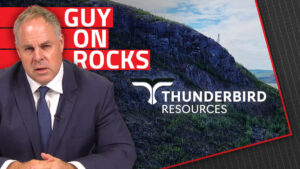Welcome to Ten-Bagger, where Lowell Resources Fund chief investment officer John Forwood gives us his take on a sector of the ASX resources market full of value.
This month, John tells us about the triple whammy that’s hit ASX small resources stocks and a couple ideas to navigate rough seas.
This week saw a momentous occasion as AI and graphics supplier Nvidia soared to a market cap of US$3.3 trillion.
In doing so it supplanted Microsoft as the world’s largest company, close to 30 years after Microsoft “almost sank” Nvidia by rejecting its early generation chip technology.
Irony aside, Lowell Resources Fund (ASX:LRT) CIO John Forwood says Nvidia’s rise to the top echelon of the equities world is significant for small mining companies, who have been hit by what he calls a ‘triple whammy’ in the past month.
“It’s not something that’s just happened overnight, but long term, you’ve got commodities underperforming or undervalued versus equities,” he told Stockhead.
“You’ve got the GSCI commodity index ratio to the S&P 500 over 30 years near 30 year lows.”
(That’s the first whammy.)
“Then you’ve got resources stocks undervalued compared to other equities,” Forwood continued.
“There are parts of the market that are really outperforming like what they call The Magnificent Seven, which includes Nvidia and Apple and everyone else is getting left behind.”
(Whammy 2.)
“And then within mining you’ve got the divergence between the the juniors and explorers, and the producers.”
(Number 3, wham, bam, thank you ma’am.)
The irony of it all is the spread of AI and information technology is, as with electric vehicles, going to increase demand for commodities even further in the years ahead.
But market sentiment is creating haves and have nots, with junior resources companies commonly on the outer.
Copper comparisons
One indicator of the growing disparity between where commodity prices and equities sit is the decoupling of the small resources index from the copper price which until a decade ago ran almost completely in lockstep.
This chart shows how much copper prices and small resources stocks have decoupled. Pic: Lowell Resources Fund
The failure of small resources stocks to recover despite copper running higher in 2024 – briefly hitting all time highs of US$10,889/t on the LME in May – has been one of the mysteries of the 2024 stock market.
Forwood said investors were increasingly becoming concerned that companies would not be able to finance projects due to escalating capital outlays that frightened bankers and left equity holders nervous about dilution.
Many companies are now caught in what Forwood called a ‘vicious circle’.
“They’ve got a project that might be shovel ready or permitted, they’ve done a feasibility study,” he noted.
“But they can’t get finance even though the feasibility study might be positive, partly because people don’t trust the costs in the feasibility study because we’ve seen quite a bit of cost escalation over the last few years.
“Funders, particularly in banks, have really retreated from the market.”
With confidence suppressing share prices, some companies may be forced to raise cash at a big discount that prevents them from picking up large sums from investors.
“If your capex requirement is $100m and you only have a $20m market cap, you may have to raise money at a substantial discount of 25%. Then you’re raising money off a $15m valuation to raise $50 million,” Forwood said.
“In rare cases this does happen but generally this just doesn’t work, even if the project has an attractive NPV and IRR.”
In times like these
When this is happening, the aim is not necessarily to be in a company that has a project ready to dig.
The biggest gains could be made in companies with the capacity to chase exploration success.
“We really look for that exploration excitement,” Forwood said.
“That’s where you can have a really quick and large run up in share price with a great drill hole. That’s one of the best ways to break out of that vicious circle of having a low market cap.
“I think companies, even if they do have a positive feasibility study in their back pocket and a project which is shovel ready, they’ve got to be out there doing exploration and showing they’re going to try and find some upside to their NPV.
“They need to show the study is not the end of the story.”
Companies at the smaller end of the market are often perpetually ‘cum issue’, Forwood said. To avoid dilution they may raise $2m at a time.
It’s enough to keep the lights on and sink a couple drill holes, but not enough to plan campaigns with a high chance of additional exploration success.
Opportunities to break the out of the circle
Forwood said WA gold explorer Ausgold (ASX:AUC) was one company which could shake off that funk, having raised a hefty $38 million this month for its 3Moz Katanning gold project.
Much of that will go to DFS activities, but Ausgold MD Matthew Greentree has also highlighted that money from the raise will be used on drilling to test targets across a 17km stretch along the KGP mine trend.
$82m capped Ausgold is only trading at 3.4c, but was able to raise the capital at a discount of just 7.68% to its 20 day VWAP.
“It’s a good looking project but they’re battling to get over that hurdle of raising the finance,” Forwood said.
“But they’ve raised this nice big chunk of money, I don’t think they’re going to be cum-issue in the next 12 months or so and they’ve got some really good exploration.
“I think actually biting the bullet and doing a big chunky raising, while it can be very dilutionary, it can help to get you out of that rut.”
IPO interest has also recovered slightly after a bone dry 2023.
Ordell Minerals, which has run a $5m float through Perth brokerage Argonaut, which Lowell supported, is one Forwood is tracking.
After Raleigh Finlayson turned Genesis Minerals (ASX:GMD) into ‘Saracen 2.0’, Ordell has been pitched as ‘Genesis 2.0’, taking the Gwalia gold mine owner’s majority stake in the non-core Barimaia project on the doorstep of Ramelius Resources (ASX:RMS) and its Mount Magnet project.
Leading the firm will be former Genesis managing director Michael Fowler and chairman Tommy McKeith, who stood aside for the ex-Saracen team of Finlayson and Tony Kiernan in 2022.
“We’ve put a reasonable chunk into the IPO, the fund’s going to have about 6% of the company I think,” Forwood said.
“That is just outside Mount Magnet, right next to Ramelius.
Mike Fowler thinks he might potentially be sitting, with a drill out, on a substantial deposit at Barimaia.
“It’s within a kilometre or so of Mt Magnet itself, and it’s going to have a post IPO market cap of $10 million – $5 million EV and $5 million in cash.
“I think it’s cheap and in a great area where there’s proven to be plenty of M&A activity over the years and good management.”
The post Ten-Bagger: John Forwood’s triple whammy is hitting ressie stocks appeared first on Stockhead.






















